The OnePlus 3 Review
by Brandon Chester on June 20, 2016 8:00 AM EST- Posted in
- Smartphones
- OnePlus
- OnePlus 3
GPU Performance
GPU performance is one of the areas where Snapdragon 810 actually tended to do quite well. It's also the case that GPUs generally see larger performance gains year over year than CPUs. We already saw how Adreno 530 performs in the LG G5 review, but the device being compared to was the LG G4, which used Snapdragon 808. The OnePlus 3 represents an opportunity to compare a Snapdragon 810 device to its successor using Snapdragon 820.
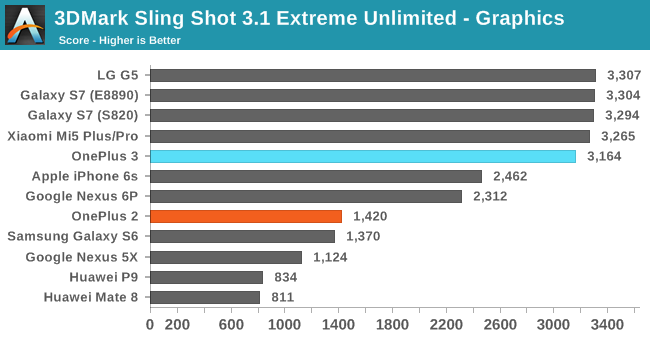
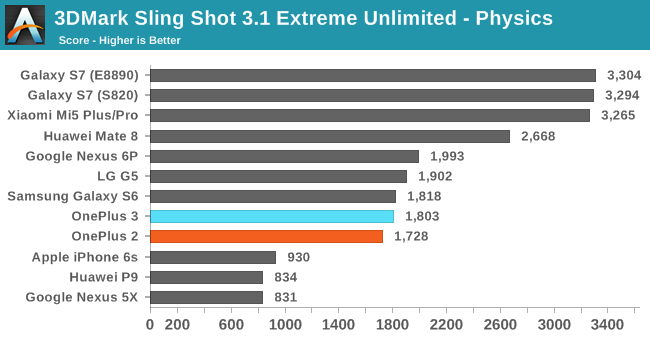
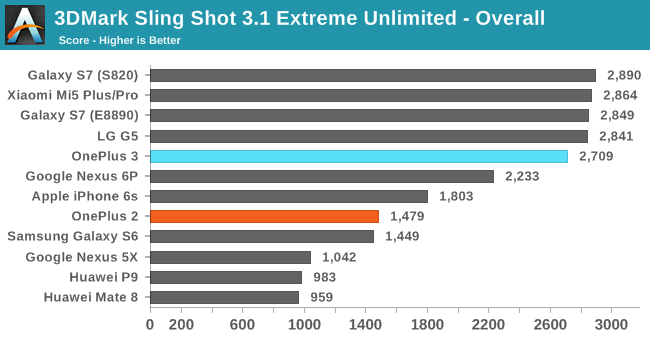
The OnePlus 3 does very well in 3DMark Sling Shot. In both the physics and graphics tests it trails the LG G5 slightly, but the gap isn't anything truly significant. Exynos 8890 is still not something I can compare to until our Galaxy S7 review is posted, but barring that it's clear that Snapdragon 820's Adreno 530 gives the fastest smartphone performance in this test, and when looking at the graphics performance the performance is over two times faster than the OnePlus 2.
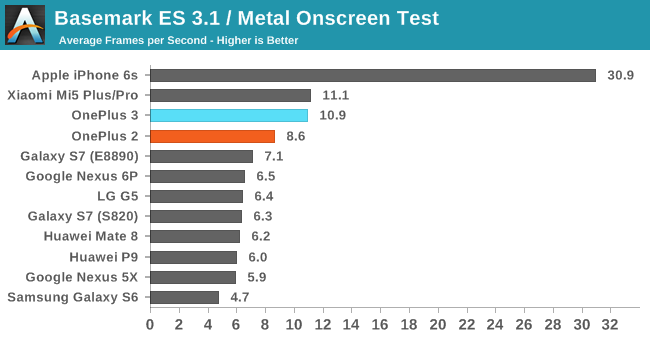
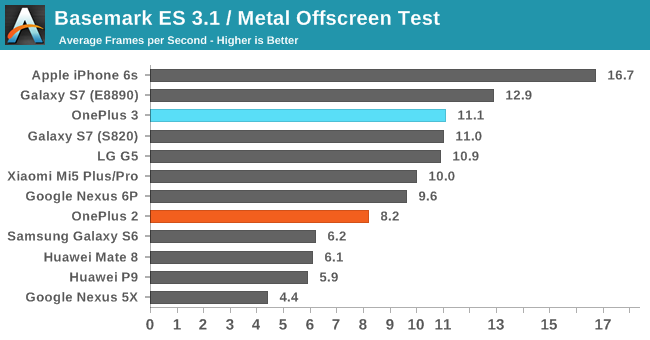
In BaseMark ES 3.1's on screen test the OnePlus 3 manages a significant lead over the LG G5 as a result of its lower resolution. In the off screen 1080p test both phones have essentially the same performance, which is what you'd expect. It looks like Adreno 530 doesn't make the same gains in this test that it does in some others, and it's not clear whether this is just the result of driver optimizations or something about the benchmark that is able to perform batter on other GPU architectures, which could be contributing to the iPhone's lead even in the off screen test.
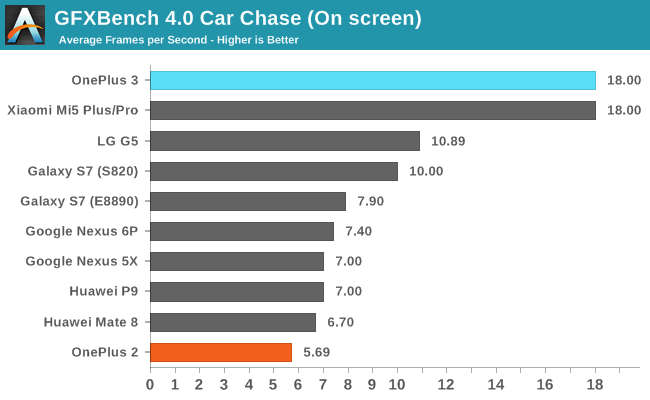
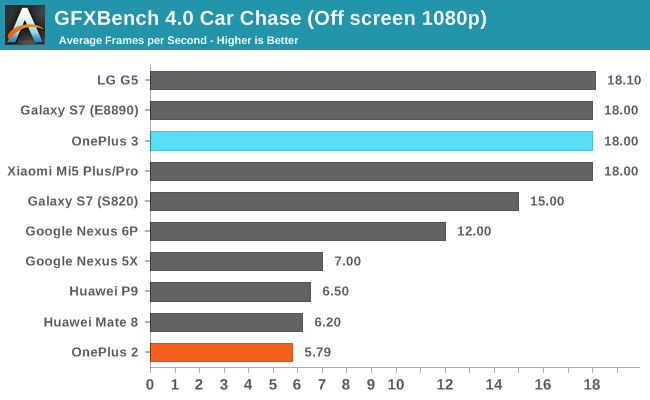
In GFXBench Car Chase the performance of the OnePlus 3 is in line with the LG G5. On screen performance is significantly higher due to the lower resolution display, while off screen performance at 1080p is about the same as the G5 and exactly the same as the on screen result. As far as absolute GPU performance goes, both of our Snapdragon 820 devices are at the top of the chart for absolute performance, and that's good news for anyone playing games or using software that benefits from a powerful mobile GPU.
NAND Performance
The OnePlus 3 moves to a UFS 2.0 NAND solution, which OnePlus claims is three times faster than the eMMC storage used in the OnePlus 2. In more realistic testing you probably won't end up achieving speeds three times faster than the OnePlus 2 since it actually wasn't slow at all by eMMC standards, but there should be a decent uplift in NAND performance nonetheless.
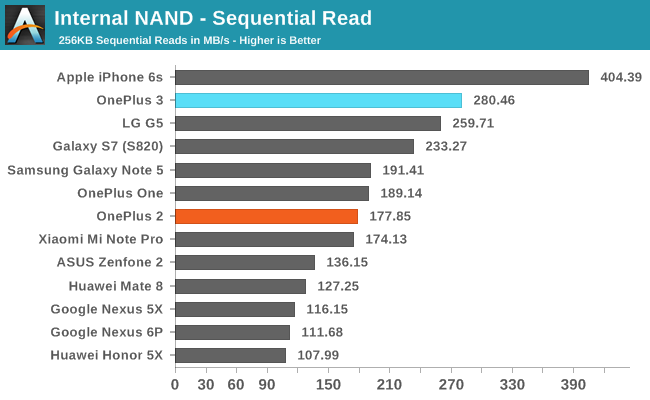
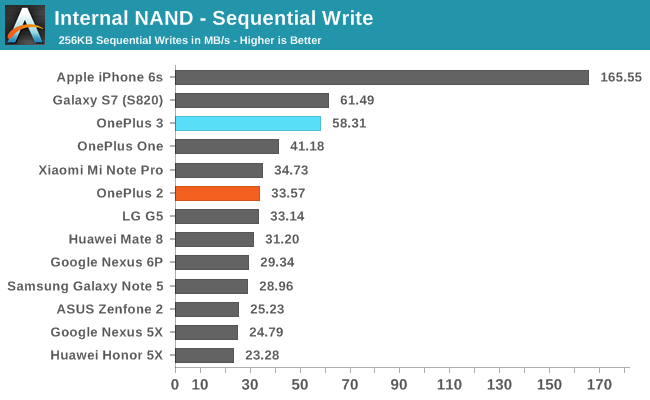
The move to UFS 2.0 brings healthy gains over the OnePlus 2's storage performance, although as I said, the OnePlus 2 didn't perform poorly at all by the standards of eMMC devices. Sequential read and write performance is actually the best that I've measured so far on an Android device. We're still not looking at anything close to what you get for sequential performance on iOS devices, but there are some other factors at play like the fact that the iPhone was a 128GB unit while our Android devices are usually 32GB or 64GB devices. In any case, the OnePlus 3 doesn't present any problems with storage performance, and you certainly won't run into the same issues that you can with budget smartphones at the $200-300 range where the eMMC solutions can be exceptionally slow.










176 Comments
View All Comments
Brandon Chester - Sunday, June 19, 2016 - link
I hope everyone is happier with the turnaround on this one c:hans_ober - Monday, June 20, 2016 - link
Yes we are! I wouldn't mind it being two or more weeks late, but 3 months is inexcusable.theduckofdeath - Monday, June 20, 2016 - link
Yeah, the delay on the big flagship reviews even makes a fast published like this one pretty pointless, as it only compares data with 2015 devices. And we've officially passed the 2016 summer solstice! Rage! \o/close - Tuesday, June 21, 2016 - link
Yes, passing the summer solstice always enrages me and saddens me a little...TheProv - Monday, June 20, 2016 - link
Why did you reported only sequential speeds and not random speeds too?Ditiris - Monday, June 20, 2016 - link
Quick turnaround, excellent review, much appreciated.Shame about the graphics display. I'm in the market, and as you say, a good display would make the phone almost a no-brainer, but instead their choices have more or less removed the phone from contention for me. Hopefully OnePlus rapidly makes good on their promise to update the display. I'll be watching for an update to your review.
Small error on the Display page:
I really don’t have anything else to say here, as I’m just so frustrated by OnePlus’s choices here,
jospoortvliet - Monday, June 20, 2016 - link
I would wait for the effect of sRGB settings but the low resolution on tgis can't be fixed of course....niva - Monday, June 20, 2016 - link
Sorry, the display is only a secondary concern for me. I'm much more concerned about the software and the updatability of the Oxygen OS. This device would be ideal as a Nexus phone, but no, that's too much to ask for.On the flip side I think sticking with 1080 is the right thing to do for a whole lot of reasons.
jospoortvliet - Monday, June 20, 2016 - link
Not pentile, though, not on this low resolution... for an ips this would be sufficient but the power usage advantage on amoled is far less and with less subpixels it really looks bad.peterfares - Monday, June 20, 2016 - link
PenTile needs to die